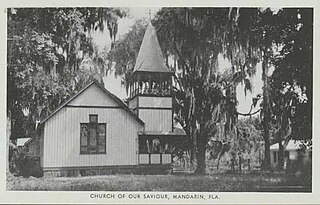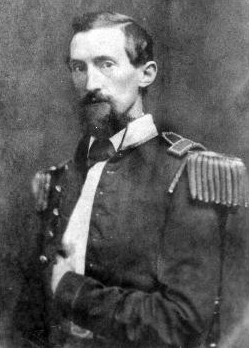
Uncle Tom's Cabin; or, Life Among the Lowly is an anti-slavery novel by American author Harriet Beecher Stowe. Published in two volumes in 1852, the novel had a profound effect on attitudes toward African Americans and slavery in the U.S., and is said to have "helped lay the groundwork for the [American] Civil War".

St. Johns County is a county in the northeastern part of the U.S. state of Florida. As of the 2020 United States census, its population was 273,425. The county seat and most populous incorporated city is St. Augustine, although the nearby community, St. Johns, has a higher population. St. Johns County is part of the Jacksonville metropolitan area.

Harriet Elisabeth Beecher Stowe was an American author and abolitionist. She came from the religious Beecher family and wrote the popular novel Uncle Tom's Cabin (1852), which depicts the harsh conditions experienced by enslaved African Americans. The book reached an audience of millions as a novel and play, and became influential in the United States and in Great Britain, energizing anti-slavery forces in the American North, while provoking widespread anger in the South. Stowe wrote 30 books, including novels, three travel memoirs, and collections of articles and letters. She was influential both for her writings as well as for her public stances and debates on social issues of the day.

Catharine Esther Beecher was an American educator known for her forthright opinions on female education as well as her vehement support of the many benefits of the incorporation of kindergarten into children's education. She published the advice manual The American Woman's Home with her sister Harriet Beecher Stowe in 1869. Some sources spell her first name as "Catherine".

Martin Johnson Heade was an American painter known for his salt marsh landscapes, seascapes, and depictions of tropical birds, as well as lotus blossoms and other still lifes. His painting style and subject matter, while derived from the romanticism of the time, are regarded by art historians as a significant departure from those of his peers.

The 74-mile-long (119 km) Ocklawaha River flows north from central Florida until it joins the St. Johns River near Palatka. Its name is derived from ak-lowahe, Creek for "muddy".

Isabella Beecher Hooker was a leader, lecturer and social activist in the American suffragist movement.

The Harriet Beecher Stowe House is a historic home in Cincinnati, Ohio which was once the residence of influential antislavery author Harriet Beecher Stowe, author of the 1852 novel Uncle Tom's Cabin.
Mandarin is a neighborhood located in the southernmost portion of Jacksonville, in Duval County, Florida, United States. It is located on the eastern banks of the St. Johns River, across from Orange Park. It's a short drive south of Jacksonville's city center, and is bordered by Beauclerc to the north, Julington Creek to the south and St. John's River to the west.

The World Golf Village (WGV) is a golf resort in St. Johns County, Florida, United States, located between Jacksonville and St. Augustine. It was created by the PGA Tour and showcases the World Golf Hall of Fame. In addition to the resort the World Golf Village features residential and commercial developments. There is also a census-designated place with the same name.
Washington is a neighborhood of the city of Maysville located near the Ohio River in Mason County in the U.S. state of Kentucky. It is one of the earliest settlements in Kentucky and also one of the earliest American settlements west of the Appalachian Mountains. It played a significant role in the lead-up to the Civil War, producing two civil war generals and an escaped slave whose legal case established Canada as a safe haven for escaping slaves. It also provided the site where Harriet Beecher Stowe witnessed a slave auction. It has since been annexed by Maysville, and is sometimes now referred to as Old Washington. The community is in Area 606 served by the 759 exchange.

The Church of Our Saviour is an Episcopal church in the Mandarin area of Jacksonville, Florida, U.S. It is located on the St. Johns River at 12236 Mandarin Road. The congregation was founded in 1880 by a group Episcopalians, Church of England members and those from other denominations who wanted to start a new church in the Anglican mode. These people had gathered for Bible readings with Professor Calvin E. Stowe and his famous wife, Harriet Beecher Stowe for many years. They constructed a small but sound church building designed by Ellis and McClure in 1883, which stood until 1964 when Hurricane Dora's winds broke off part of a giant Live Oak and sent it crashing through the church's roof. The Stowe Memorial stained glass window, created by Louis Comfort Tiffany, was completely destroyed. The congregation built a new church in a similar design; it remains an active parish in the Episcopal Diocese of Florida.

Francis Asbury Shoup, a lawyer from Indianapolis, Indiana, became a brigadier general for the Confederate States Army during the American Civil War.

The Harriet Beecher Stowe House is a historic home and National Historic Landmark at 63 Federal Street in Brunswick, Maine, notable as a short-term home of Harriet Beecher Stowe and Calvin Ellis Stowe and where Harriet wrote her 1852 novel Uncle Tom's Cabin. Earlier, it had been the home of Henry Wadsworth Longfellow as a student. It is today owned by Bowdoin College. A space within the house, called Harriet's Writing Room, is open to the public.

Calvin Ellis Stowe was an American Biblical scholar who helped spread public education in the United States. Over his career, he was a professor of languages and Biblical and sacred literature at Andover Theological Seminary, Dartmouth College, Lane Theological Seminary, and Bowdoin College. He was the husband and literary agent of Harriet Beecher Stowe, author of the best-seller Uncle Tom's Cabin.

Walnut Hills is one of the 52 neighborhoods of Cincinnati, Ohio. One of the city's oldest hilltop neighborhoods, it is a large diverse area on the near east side of Cincinnati. The population was 6,344 in the 2020 census.

Palmetto Leaves is a memoir and travel guide written by Harriet Beecher Stowe about her winters in the town of Mandarin, Florida, published in 1873. Already famous for having written Uncle Tom's Cabin (1852), Stowe came to Florida after the U.S. Civil War (1861–1865). She purchased a plantation near Jacksonville as a place for her son to recover from the injuries he had received as a Union soldier and to make a new start in life. After visiting him, she became so enamored with the region she purchased a cottage and orange grove for herself and wintered there until 1884, even though the plantation failed within its first year. Parts of Palmetto Leaves appeared in a newspaper published by Stowe's brother, as a series of letters and essays about life in northeast Florida.
Julington Creek is a stream in Saint John County, Florida, near Jacksonville. Durbin Creek is a tributary. Julington Creek feeds into the St Johns River widening out into Old Bull Bay. Both are navigable by paddlecraft and has a marina on it.

Tocoi Creek High School (TCHS) is a new public high school in the World Golf Village census-designated place, in north central area of St. Johns County, Florida near St. Augustine. It is part of the St. Johns County School District and opened to students for the 2021-22 academic year.
Tocoi Creek is a tributary of the St. Johns River in St. Johns County, Florida. Kayakers report seeing abundant wildlife including turtles, alligators, and osprey and what is left of an old steamship dock as they paddle the creek. The creek is named after a Timucuan word that means water lily. The indigenous Timucua lived in the area prior to European contact in the 1500s through about 1800.
















